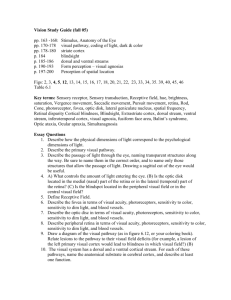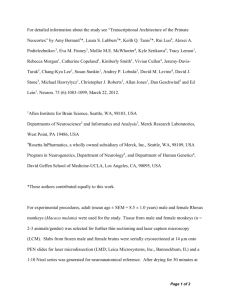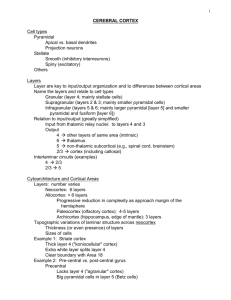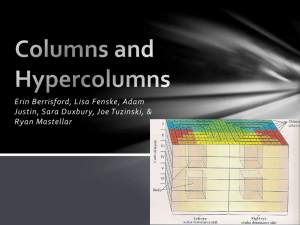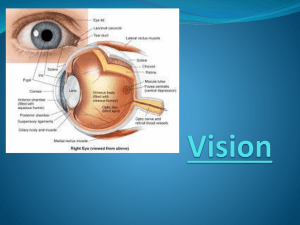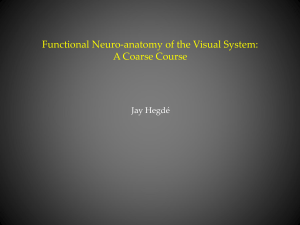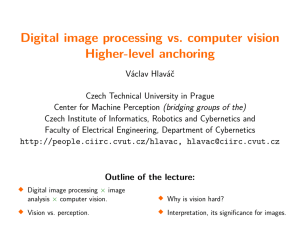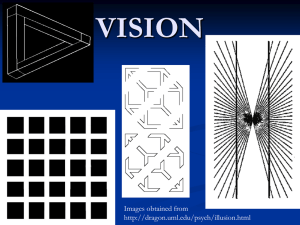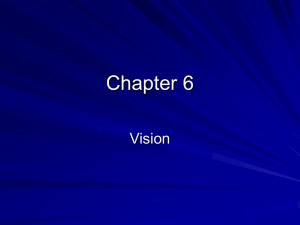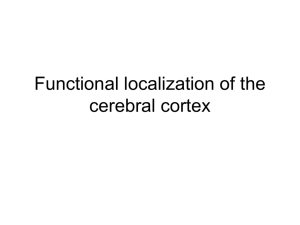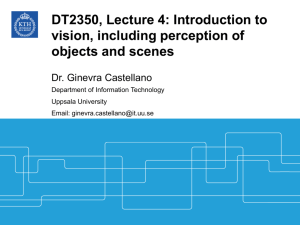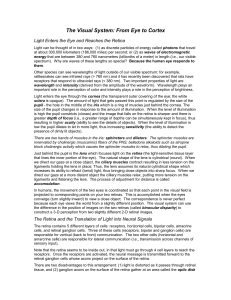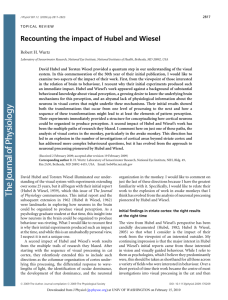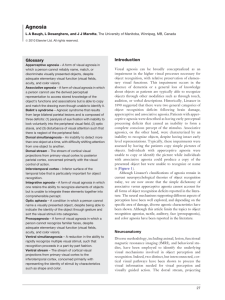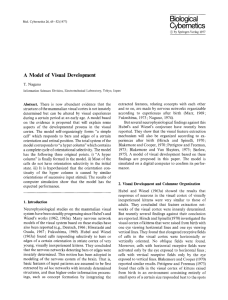Chapter 6 Lecture Notes Page
advertisement
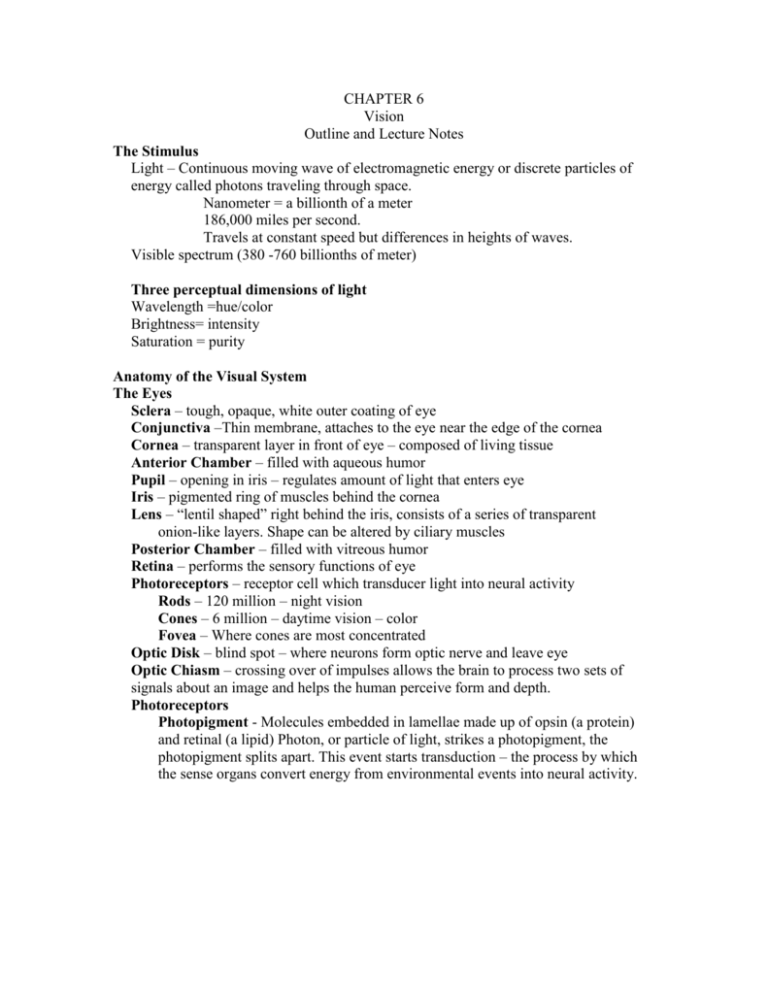
CHAPTER 6 Vision Outline and Lecture Notes The Stimulus Light – Continuous moving wave of electromagnetic energy or discrete particles of energy called photons traveling through space. Nanometer = a billionth of a meter 186,000 miles per second. Travels at constant speed but differences in heights of waves. Visible spectrum (380 -760 billionths of meter) Three perceptual dimensions of light Wavelength =hue/color Brightness= intensity Saturation = purity Anatomy of the Visual System The Eyes Sclera – tough, opaque, white outer coating of eye Conjunctiva –Thin membrane, attaches to the eye near the edge of the cornea Cornea – transparent layer in front of eye – composed of living tissue Anterior Chamber – filled with aqueous humor Pupil – opening in iris – regulates amount of light that enters eye Iris – pigmented ring of muscles behind the cornea Lens – “lentil shaped” right behind the iris, consists of a series of transparent onion-like layers. Shape can be altered by ciliary muscles Posterior Chamber – filled with vitreous humor Retina – performs the sensory functions of eye Photoreceptors – receptor cell which transducer light into neural activity Rods – 120 million – night vision Cones – 6 million – daytime vision – color Fovea – Where cones are most concentrated Optic Disk – blind spot – where neurons form optic nerve and leave eye Optic Chiasm – crossing over of impulses allows the brain to process two sets of signals about an image and helps the human perceive form and depth. Photoreceptors Photopigment - Molecules embedded in lamellae made up of opsin (a protein) and retinal (a lipid) Photon, or particle of light, strikes a photopigment, the photopigment splits apart. This event starts transduction – the process by which the sense organs convert energy from environmental events into neural activity. Chain of events in Visual Perception – The primary retino-geniculo-cortical pathway. 1. When a molecule of rhodopsin is exposed to a quantum of light it breaks into two constituents; rod opsin and retinal 2. Ion Channels are open. Glutimate (neurotransmitter) flowing (dark current) Ion channels now closes or hyperpolarize NO ACTION POTENTIAL 3. Reduction of glutamate causes bipolar cell to depolarize and the bipolar cell releases more glutamate NO ACTION POTENTIAL. 4. Increase of glutamate causes the ganglion cell to be excited and creates an action potential. 5. The action potential of ganglion cell sends info via optic nerve to DLGN (dorsal lateral geniculate nucleus) of thalamus 6. The DLGN of thalamus has 6 layers. Layers 1 and 2 are magnocellular layers found in all mammals –transmit B & W images and movement. Layers 3, 4, 5, and 6 are parvocellular layers found in primates only – transmit color vision 7. Neurons of the DLGN send their axons to the primary visual cortex or striate cortex in the occipital lobe Analysis of Visual Information: Role of the Striate Cortex Anatomy of the Striate Cortex Six layers Magnocellular, - B&W Parvocellular - Red and Green cones Koniocellular – blue cones Modular Organization of the Striate Cortex 2500 modules, each containing approx. 150,000 neurons CO blobs – Each half of a module receives information from one eye, but because information is shared, most of the neurons respond to input from both eyes Analysis of Visual Information: Role of the Visual Association Cortex Two Streams of Visual Analysis Dorsal - “Where things are” Optic ataxia – can perceive it, but when reaching for it is often misdirected Ocular apraxia – “without visual action” unable to make a systematic scan of contents of room Simultanagnosia – can perceive only one object at a time Balint’s syndrome- all three – bilateral damage to dorsal stream parieto-occipital region Ventral – “What things are” Visual agnosia – Cannot identify common objects by sight – inferior temporal cortex 1. Apperceptive visual agnosia – cannot recognize objects by shape Prosopagnosia- inability to recognize faces – fusiform face area in extrastriate cortex of occipital lobe (a form of apperceptive visual agnosia) 2. Associative visual agnosia – perceive normally, but cannot name what they have seen Perception of Color “Achromatopsia” – vision without color – anterior to V4 – area V8 Perception of Movement Area V5 – posterior parietal cortex – damage here disrupts ability to perceive movement or spatial location of objects “Akinetopsia” – inability to perceive movement caused by damage to area V5 of the visual association cortex Perception of Spatial Location The parietal lobe is involved with spatial perception – Damage to the parietal lobes disrupts a variety of tasks requiring perception and memory of the location of objects. Causes of Blindness and vision impairment Cataract Glaucoma Macular Degeneration Retinitis Pigmentosa
